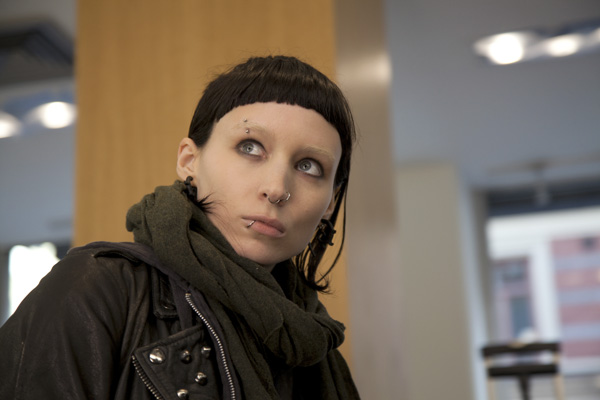
Rooney Mara in THE GIRL WITH THE DRAGON TATTOO (Sony PIctures Entertainment)
If you’re one of the 65 million around the world who read Stieg Larsson’s novel The Girl With The Dragon Tattoo, and made last year’s Swedish film adaptation the biggest U.S. box office draw for a subtitled film in a decade, would you still want to see how Hollywood reworks the convoluted, excruciatingly violent story? Hell, yes.
Atypical for American remakes of foreign films, director David Fincher and scriptwriter Steven Zaillian keep the original Swedish setting (it’s the first major Hollywood production filmed in the country), though the opening news reports of a CEO avoiding charges of corporate malfeasance seem very au courant here. (As part of the nod to atmospheric authenticity, the top-notch ensemble of international actors speaks English with a Swedish accent; the barrage of headlines, TV coverage, and old reports are in Swedish, while key clues are seen and heard in English.) In Stockholm, investigative journalist Mikael Blomkvist (Daniel Craig) has ruined his reputation and the finances of his Millennium Magazine in pursuing this alleged white-collar criminal with untrustworthy sources.
Meanwhile, elderly lawyer Dirch Frode (Steven Berkoff) commissions a confidential investigation of Blomkvist through a security firm headed by Armansky (Goran Visnjic), who is very protective of his very different, very private top researcher, the black-clad Lisbeth Salander (Rooney Mara, who got piercings and bleached eyebrows for her dramatic transformation into The Girl). She has a militant Mohawk, but can barely bring herself to look at the two men as she reports on the intimate details of Blomkvist’s life that could only be known through computer hacking and bugging. (At least she’s not doing it for a tabloid.) After hooking up with a sultry girlfriend where her titular tattoo is revealed on her shoulder, Salander has to report to a new legal guardian for her allowance. That’s humiliating enough, but Nils Bjurman (Yorick van Wageningen) makes this requirement even worse, much, much worse for her. (While you will be revolted and shocked by Bjurman’s cheerfully horrific behavior, I hasten to note that the Dutch actor was seen earlier this year as a charmingly affable pilgrim in Emilio Estevez’s The Way.)
While she determinedly plots her revenge in what will be a very visually explicit—in every way—tit-for-tat mission, Blomkvist leaves the modern capital city to go north and seemingly back in time when he agrees to work for Frode’s client, patriarch Henrik Vanger (Christopher Plummer), to solve a 40-year-old mystery—the murder of his favorite niece, Harriet, on a hot summer night. Blomkvist settles into a cottage on a private island, the home to the old-money Vangers, the beneficiaries of the country’s largest family-owned company, which had profited from Nazi collaboration (an ironic source of funds to later bail out Blomkvist’s muckraking magazine). Harriet’s brother Martin (Stellan Skarsgard), now head of the company, welcomes Blomkvist in order to humor the old man, and among the nasty relatives, neither her mother (Geraldine James) nor her cousin Anita (Joely Richardson) in London even want to talk to him.
When Blomkvist challenges Salander to help him pursue clues that Harriet’s death could be linked to a series of murders, he intrigues her (and appeals to her personal vengeance ethic) by referencing Larsson’s original title for his novel, Men Who Hate Women, “I want you to help me catch a killer of women.” Their charged partnership works more credibly here than either in the book or the earlier movie, where Larsson’s paunchy, middle-aged alter ego seemed too much of a male fantasy projection. From the James Bond resonance of the opening titles (designed by Blur Studio and set to the thrillingly propulsive music by Trent Reznor and Atticus Ross), Craig looks quite fetching lounging at a computer in a near-thong, while Salander is very much the aggressor in moving their relationship to a physical connection when his defenses are drunkenly down and her hard shell begins to melt.
As their research slices through the book’s chunky exposition, briefly leaving in some of the distinctive tertiary characters, most of the compression of the revelations works well, while the storyline extends a ways into the second book to tie up the opening financial crime and leaves some suggestive clues for the direction of the rest of the trilogy. Though the climactic sadistic torture and villain’s confession scene is still problematic (at least the viewer doesn’t get inured to the violence), Fincher’s creative team from The Social Network, including cinematographer Jeff Cronenweth, production designer Donald Graham Burt, and editors Kirk Baxter and Angus Wall, turn dusty archives, maps, old photographs, tinged summer flashbacks and guerrilla computer hacking into an exciting, fast-paced chase. With great pizzazz, their original style wrings suspense from the aspects that are a pastiche of other thrillers.
















Leave A Comment